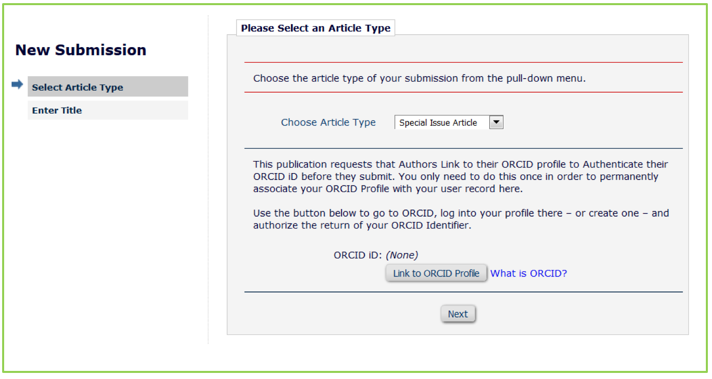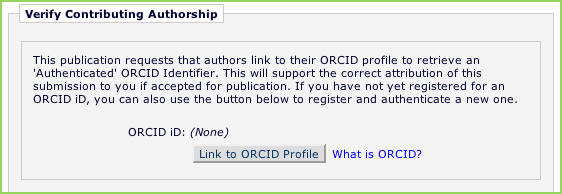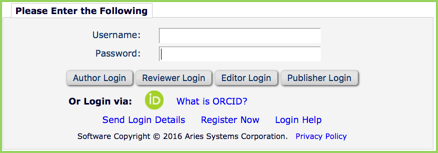ORCID Solicitation: Exploring the options in Editorial Manager
Increasingly, publishers require that authors provide their unique ORCID iD along with files and other metadata when submitting work for publication in peer reviewed journals.
Not all journals are ready to mandate ORCID for all participants in peer review workflows. For example, a journal may want to mandate ORCID for corresponding authors of original research, but not for other article types (such as letters, or book reviews) and not for other roles, such as reviewers or co-authors.
For this reason, Editorial Manager includes several journal-controlled configuration options that allow journals to select the level of ORCID solicitation that works best for their community. And, because Editorial Manager is configurable, journals can easily activate and de-activate different levels of compliance to experiment with user adoption over time.
Can ORCID be required for registration in EM?
Yes. It is possible to require an ORCID iD as part of the registration process. However, as discussed below, this does not necessarily mean that co-authors or reviewers are forced to link their ORCID iDs.
Can I exclude the ORCID requirement for co-authors?
Yes, you can. Not all journals are ready to require ORCIDs for all contributors and want to limit the requirement just to the submitting authors.
By default, Editorial Manger does not require co-authors to register. However, as explained below, co-authors can be solicited for their ORCID using an automated confirmation email.
Can I exclude the ORCID requirement for reviewers?
Yes. In EM, the journal administrator can select an option called “Expedited Reviewer Log-In.” This option effectively means that invited reviewers are exempted from entering required registration fields (including ORCID iDs) that are otherwise required for registration/log-in.
What is the difference between a “fetched” ORCID iD and a “confirmed” ORCID iD?
An ORCID iD that is “fetched” has simply been pulled into EM, possibly by a corresponding author or a journal editor. “Verified,” “authenticated,” or “confirmed” iDs have been confirmed by the owner of the ORCID. Confirmation happens only when the owner of the iD logs in using their ORCID credentials, thus lending legitimacy to the entry. In EM, an ORCID iD that has been authenticated will appear with this icon next to it: ![]()
Can journals solicit ORCID iDs based on article types?
 Yes. Journals can solicit ORCID iDs based on the user’s selection of a particular article type. For example, this means that ORCIDs can be requested for a Special Issue Article, but not for other article types, such as letters to the editor or book reviews.
Yes. Journals can solicit ORCID iDs based on the user’s selection of a particular article type. For example, this means that ORCIDs can be requested for a Special Issue Article, but not for other article types, such as letters to the editor or book reviews.
Can co-authors be asked to “confirm” their ORCID iDs?
 Yes. During submission, the corresponding author can be asked to “fetch” co-author ORCID IDs. These become part of the manuscript record in Editorial Manager.
Yes. During submission, the corresponding author can be asked to “fetch” co-author ORCID IDs. These become part of the manuscript record in Editorial Manager.
In addition, an automated email can be triggered to all co-authors to confirm their contribution to the manuscript. This email can include a link taking them to a page where they can “confirm” their ORCID. Once they have done this, the “fetched” iD becomes a “confirmed” iD.
Can ORCID be used for EM log-in?
 Yes, ORCID credentials can be used to log-in to journal sites where ORCID Single-Sign-On functionality has been activated (similar to Facebook Single-Sign-On). Rather than logging-in with an EM username and password, the user clicks on the “iD” button, and is brought to an ORCID page where they enter their ORCID credentials to sign-in. Watch a video to see how this works.
Yes, ORCID credentials can be used to log-in to journal sites where ORCID Single-Sign-On functionality has been activated (similar to Facebook Single-Sign-On). Rather than logging-in with an EM username and password, the user clicks on the “iD” button, and is brought to an ORCID page where they enter their ORCID credentials to sign-in. Watch a video to see how this works.
What about post-acceptance production workflow?
After manuscript acceptance, ORCID data can be exported to a third party production tracking systems in XML using the JATS DTD. However, journals using ProduXion Manager ®benefit from the comprehensive ORCID options detailed above throughout the production workflow. This means, for example, that co-authors can continue to be prompted to “confirm” their ORCID iDs throughout the workflow.

